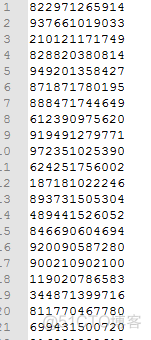标准类库-数据类型之集合-容器数据类型
by:授客 QQ:1033553122
Counter对象
例子>>> from collections import Counter
>>> cnt = Counter()
>>> for word in ['red', 'blue', 'red', 'green', 'blue', 'blue']:
cnt[word] += 1 # 等同 cnt[word] = cnt[word] + 1
cnt[word] 每个list元素出现的次数,但是这里相加时会自动去掉重复统计
>>> cnt
Counter({'blue': 3, 'red': 2, 'green': 1})
test.txt内容如下
the and to of you a my hamlet in
the and to of you a my hamlet in
the and to of you a my hamlet in
the to of you a my hamlet in
the of you a my hamlet in
the you a my hamlet in
the a my hamlet in
the my hamlet in
the hamlet in
the in
in
good by 2016
shouke 2017
1099
study python Counter
>>> import re
>>> words = re.findall(r'\w+', open('d:\\test.txt').read().lower())
>>> print(words)
['the', 'and', 'to', 'of', 'you', 'a', 'my', 'hamlet', 'in', 'the', 'and', 'to', 'of', 'you', 'a', 'my', 'hamlet', 'in', 'the', 'and', 'to', 'of', 'you', 'a', 'my', 'hamlet', 'in', 'the', 'to', 'of', 'you', 'a', 'my', 'hamlet', 'in', 'the', 'of', 'you', 'a', 'my', 'hamlet', 'in', 'the', 'you', 'a', 'my', 'hamlet', 'in', 'the', 'a', 'my', 'hamlet', 'in', 'the', 'my', 'hamlet', 'in', 'the', 'hamlet', 'in', 'the', 'in', 'in', 'good', 'by', '2016', 'shouke', '2017', '1099', 'study', 'python', 'counter']
>>> Counter(words).most_common(10)
[('in', 11), ('the', 10), ('hamlet', 9), ('my', 8), ('a', 7), ('you', 6), ('of', 5), ('to', 4), ('and', 3), ('2016', 1)]
说明:\w 只匹配字母和数字字符
类说明
class collections.Counter([iterable-or-mapping])
Counter,用于统计哈希对象的dict子类,是一个无序集合,把被统计元素存储为字典的键,而把对应元素出现的次数存储为字典的值。
可统计可迭代对象(iterable)、其它mapping对象、counter中的元素
>>> c = Counter() # 空的 counter
>>> c
Counter()
>>> c = Counter('gallahad') # 通过可迭代对象(字符串)创建的counter
>>> c
Counter({'a': 3, 'l': 2, 'd': 1, 'h': 1, 'g': 1})
>>> c = Counter([2, 3, 4, 3, 3, 4]) # 通过可迭代对象(List)创建的counter
>>> c
Counter({3: 3, 4: 2, 2: 1})
>>> c = Counter({'red':4, 'blue':2}) # 通过mapping对象(字典)创建的counter
>>> c
Counter({'red': 4, 'blue': 2})
>>> c = Counter(cats=4, dogs=8) # 通过关键字参数创建的counter
>>> c
Counter({'dogs': 8, 'cats': 4})
Counter对象拥有字典的接口,可通过字典方式,如counter[element]获取element的统计次数,如果key即element不存在,则返回0
>>> c = Counter(['eegs', 'ham'])
>>> c
Counter({'ham': 1, 'eegs': 1})
>>> c['bacon']
0
修改某个元素的统计次数,然后使用del移除该元素的统计
>>> c = Counter(['shouke', 'shouke', '2017'])
>>> c
Counter({'shouke': 2, '2017': 1})
>>> c['shouke'] = 1
>>> c
Counter({'shouke': 1, '2017': 1})
>>> del c['shouke']
>>> c
Counter({'2017': 1})
3.1中新增
对象方法
除了支持字典对象所拥的方法之外,Counter对象还支持以下三种方法
elements()
返回一个List,如果存在被统计元素,且元素统计次数大于0,假设为N,则该元素会在list中重复出现N次。List中元素未知顺序任意。
>>> c = Counter(a=4, b=2, c=0, d=-2)
>>> c.elements()
>>> list(c.elements())
['b', 'b', 'a', 'a', 'a', 'a']
注意:统计次数小于0的元素被忽略了。
most_common([n])
返回元素统计次数排名前N位的元素,如果不指定N,默认返回全部元素的统计。如果元素彼此的统计次数相等,则元素的顺序任意。
>>> Counter('abracadabra').most_common(3)
[('a', 5), ('b', 2), ('r', 2)]
subtract([iterable-or-mapping])
counter相减(对应元素的统计次数相减)
>>> c = Counter(a=4, b=2, c=0, d=-2)
>>> d = Counter(a=1, b=2, c=3, d=4)
>>> c.subtract(d)
>>> c
Counter({'a': 3, 'b': 0, 'c': -3, 'd': -6})
>>> d = Counter(a=1, b=2, c=3, d=4, e=2)
>>> c.subtract(d)
>>> c
Counter({'a': 2, 'b': -2, 'e': -2, 'c': -6, 'd': -10})
说明:如上,如果后一个counter中的元素在前一个counter中未出现,则默认前一个counter中该元素的统计次数为0
3.2中新增
以下两个常规的字典方法,对于Counter对象,有点不一样
fromkeys(iterable)
该方法对于counter对象来说,未实现。
update([iterable-or-mapping])
根据提供的可迭代对象,或者映射对象,或者counter更新统计次数。可迭代对象,期望是元素序列,而(key,value)非键值对序列
>>> c = Counter(a=4, b=2, c=0, d=-2)
>>> c.update(['d', 'd', 'a', 'c', 'e'])
>>> c
Counter({'a': 5, 'b': 2, 'c': 1, 'e': 1, 'd': 0})
Counter对象常见使用模式
>>> c
Counter({'a': 5, 'b': 2, 'c': 1, 'e': 1, 'd': 0})
>>> sum(c.values()) # 获取元素统计次数之和
9
>>> c.clear() # 清空统计
>>> c
Counter()
>>> c = Counter(['shou', 'ke', '2014', '2017', '2017'])
>>> c
Counter({'2017': 2, '2014': 1, 'ke': 1, 'shou': 1})
>>> list(c) # 返回元素的list表示,元素唯一,不改变Counter对象
['2017', '2014', 'ke', 'shou']
>>> set(c) # 返回元素的set集合,不改变Counter对象
{'2017', '2014', 'ke', 'shou'}
>>> dict(c) # 返回包含elem:cnt(元素:统计次数)对的字典,不改变Counter对象
{'2017': 2, '2014': 1, 'ke': 1, 'shou': 1}
>>> c.items() # 所有统计项
dict_items([('2017', 2), ('2014', 1), ('ke', 1), ('shou', 1)])
# Counter(dict([(elem,cnt),(elem,cnt)])) # 从包含(elem,cnt)对的list创建counter对象
>>> Counter(dict([('shou',2),('ke',1)]))
Counter({'shou': 2, 'ke': 1})
# c.most_common()[:-n:-1],返回统计次数最少的前 n-1项
>>> c.most_common()[:-3:-1]
[('shou', 1), ('ke', 1)]
>>> c = Counter(dict([('shou', 1), ('ke',2), ('2014', 0),('2017',-1)]))
>>> +c # 返回移除了统计值为0、负数的统计项后的Counter
Counter({'ke': 2, 'shou': 1})
>>> c
Counter({'ke': 2, 'shou': 1, '2014': 0, '2017': -1})
>>>
数学运行
输出只会保留统计大于0的统计项
>>> c = Counter(a=3, b=1)
>>> d = Counter(a=1, b=2)
>>> c + d # c[x] + d[x]
Counter({'a': 4, 'b': 3})
>>> c -d # c[x] - d[x]
Counter({'a': 2}) #忽略了统计值为0的项
>>> c & d # min(c[x], d[x])
Counter({'b': 1, 'a': 1})
>>> c | d # max(c[x], d[x])
Counter({'a': 3, 'b': 2})
添加空的Counter、用空的counter减去当前Counter的简写方法
>>> c = Counter(a=2, b=-4)
>>> +c
Counter({'a': 2})
>>> -c
Counter({'b': 4})
>>>
3.3新增
New in version 3.3: Added support for unary plus, unary minus, and in-place multiset operations
应用举例
类似如下的一个列表,数据总量达100w,要提取其中重复的数据。

解决方案:逐行读取,把读取的数据保存在list中,然后如下,构造Counter对象,然后判断Counter对象中,元素统计值是否大于1,大于1则表明存在重复数据,print,(实践测试,实际处理耗时: 1s)
# 获取重复数据
c
= Counter(list_data)
for
item
in
c.items():
if
item[1]
>
1:
print('重复数据:%s'
% item[0])
查看更多类型介绍,烦参考官方文档





















